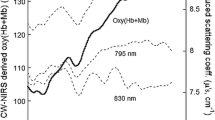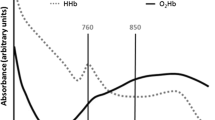Abstract
Objective. Near-infrared spectroscopy (NIRS) is a promising non-invasive technique for the continuous monitoring of tissue oxygen delivery. NIRS detects light absorbance of haemoglobin chromophores to determine tissue oxygen saturation (StO2). As skin colour is also determined by the presence of chromophores, it is plausible that NIRS signal quality may be affected by dark skin pigmentation. Methods. Tissue saturation in the anterior compartment of the lower leg during isometric contraction was measured using NIRS in 17 volunteers with dark skin pigmentation. Measurements were continued until StO2 was zero percent or until the signal disappeared. Results. The NIRS device failed to register tissue saturation values at some point in nine of seventeen volunteers. This occurred more often in individuals with darker skin. Conclusions. In patients with a dark pigmented skin, NIRS StO2 measurements should be interpreted with caution, as melanin clearly interferes with the quality of the reflected NIRS signal.
Similar content being viewed by others
References
Mancini DM, Bolinger L, Li H, Kendrick K, Chance B, Wilson JR. Validation of near-infrared spectroscopy in humans. J Appl Physiol 1994; 77(6): 2740–2747.
Jöbsis FF. Noninvasive, infrared monitoring of cerebral and myocardial oxygen sufficiency and circulatory parameters. Science 1977; 198(4323): 1264–1267.
McCormick PW, Stewart M, et al. Noninvasive cerebral optical spectroscopy for monitoring cerebral oxygen delivery and hemodynamics. Crit Care Med 1991; 19: 89–97.
McCormick PW, Stewart M, Goetting MG, Balakrishnan G. Regional cerebrovascular oxygen saturation measured by optical spectroscopy in humans. Stroke 1991; 22(5): 596–602.
Simonson SG, Piantadosi CA. Near-infrared spectroscopy. Clinical applications. Crit Care Clin 1996; 12(4): 1019–1029.
Breit GA, Gross JH, Watenpaugh DE, Chance B, Hargens AR. Near-infrared spectroscopy for monitoring of tissue oxygenation of exercising skeletal muscle in a chronic compartment syndrome model. JBJS Am 1997; 79: 838–843.
Mohler LR, Styf JR, Pedowitz RA, Hargens AR, Gershuni DH. Intramuscular deoxygenation during exercise in patients who have chronic anterior compartment syndrome of the leg. JBJS Am 1997; 79: 844–849.
Garr JL, Gentilello LM, Cole PA, Mock CN, Matsen FA. Monitoring for compartmental syndrome using near-infrared spectroscopy: A non-invasive, continuous, transcutaneous monitoring technique. J Trauma 1999; 46(4): 613–616.
Arbabi S, Brundage SI, Gentilello LM. Near-infrared spectroscopy: A potential method for continuous transcutaneous monitoring for compartmental syndrome in the critically injured patients. J Trauma 1999; 47(5): 829–833.
Gianotti G, Cohn SM, Brown M, Varela JE, McKenney MG, Wiseberg JA. Utility of near-infrared spectroscopy in the diagnosis of lower extremity compartment syndrome. J Trauma 2000; 48(3): 396–399.
Svendsen LB, Flink P, Wojdemann M, Riber C, Mogensen T, Secher NH. Muscle oxygen saturation during surgery in the lithotomy position. Clin Physiol 1997; 17(5): 433–438.
Gentilello LM, Sanzone A, Wang L, Liu PY, Robinson L. Near-infrared spectroscopy versus compartment pressure for the diagnosis of lower extremity compartmental syndrome using electromyography-determined measurements of neuromuscular function. J Trauma 2001; 51(1): 1–8.
Pringle J, Art T, Lekeux P. Near infrared spectroscopy for non-invasive assessment of intracranial haemoglobin oxygenation in an in vitro model of the calf head. Res Vet Sci 1998; 65(2): 103–109.
Brawanski A, Faltermeier R, Rothoerl RD, Woertgen C. Comparison of near-infrared spectroscopy and tissue p(O2) time series in patients after severe head injury and aneurismal subarachnoid hemorrhage. J Cereb Blood Flow Metab 2002; 22(5): 605–611.
Beilman GJ, Groehler KE, Lazaron V, Ortner JP. Near-infrared spectroscopy measurement of regional tissue oxyhemoglobin saturation during hemorrhagic shock. Shock 1999; 12(3): 196–200.
Quaresima V, Lepanto R, Ferrari M. The use of near-infrared spectroscopy in sports medicine. J Sports Med Phys Fitness 2003; 43(1): 1–13.
Boushel R, Piantadosi CA. Near-infrared spectroscopy for monitoring muscle oxygenation. Acta Physiol Scand 2000; 168(4): 615–622.
Varela JE, Cohn SM, Gianotti GD, Dolich MO, Ramon H, Wiseberg JA, McKenney M. Near-infrared spectroscopy reflects changes in mesenteric and systemic perfusion during abdominal compartment syndrome. Surgery 2001; 129(3): 363–370.
Bleehen SS. Disorders of skin colour. In: Champion RH, (ed.) Textbook of Dermatology. Oxford: Rook, Wilkinson and Ebling, 1998: 1753–1755.
Van den Brand JG, Verleisdonk EJ, Van der Werken C. Near infrared spectroscopy in the diagnosis of chronic exertional compartment syndrome. Am J Sports Med 2004; 32: 452–456.
Young AR. Chromophores in human skin. Phys Med Biol 1997; 42: 789–802.
Clarys P, Alewaeters K, Lambrecht R, Barel AO. Skin color measurements: Comparison between three instruments: The Chromameter, the DermaSpectrometer and the Mexameter. Skin Res Technol 2000; 6: 230–238.
Anderson DL, Houk GL, Lewandowski MS, Myers DE, Ortner JP. Tissue Chromophore Measurement System. U.S. Patent No. 5,879,294 March 1999.
Matcher SJ, Cooper CE. Absolute quantification of deoxyhaemoglobin concentration in tissue near infrared spectroscopy. Phys Med Biol 1994; 39: 1295–1212.
Myers DE. Total Hemoglobin Concentration Measurement. U.S. Patent No. 6,473,632 October 2002.
Meglinski IV, Matcher SJ. Computer simulation of the skin reflectance spectra. Comput Methods Prog Biomed 2003; 70: 179–186.
Author information
Authors and Affiliations
Corresponding author
Rights and permissions
About this article
Cite this article
Wassenaar, E.B., Van den Brand, J.G.H. Reliability of Near-Infrared Spectroscopy in People With Dark Skin Pigmentation. J Clin Monit Comput 19, 195–199 (2005). https://doi.org/10.1007/s10877-005-1655-0
Received:
Revised:
Accepted:
Issue Date:
DOI: https://doi.org/10.1007/s10877-005-1655-0




